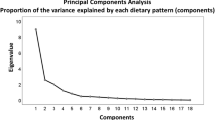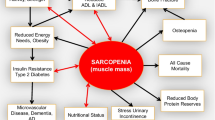Abstract
Summary
In a 4-year follow-up study that enrolled 1099 subjects aged ≥60 years, sarcopenia prevalence was estimated at 8.2%. Moreover, the presence of osteoporosis was significantly associated with short-term sarcopenia occurrence, but the reciprocal relationship was not observed, suggesting that osteoporosis would increase the risk of osteoporotic fracture and sarcopenia occurrence.
Introduction
The present 4-year follow-up study was performed to clarify the prevalence, incidence, and relationships between sarcopenia (SP) and osteoporosis (OP) in older Japanese men and women.
Methods
We enrolled 1099 participants (aged, ≥60 years; 377 men) from the second survey of the Research on Osteoarthritis/Osteoporosis against Disability (ROAD) study (2008–2010) and followed them up for 4 years. Handgrip strength, gait speed, skeletal muscle mass, and bone mineral density were assessed. SP was defined according to the Asian Working Group for Sarcopenia. OP was defined based on the World Health Organization criteria.
Results
SP prevalence was 8.2% (men, 8.5%; women, 8.0%) in the second survey. In those with SP, 57.8% (21.9%; 77.6%) had OP at the lumbar spine L2–4 and/or femoral neck. SP cumulative incidence was 2.0%/year (2.2%/year; 1.9%/year). Multivariate regression analysis revealed that OP was significantly associated with SP occurrence within 4 years (odds ratio, 2.99; 95% confidence interval, 1.46–6.12; p < 0.01), but the reciprocal relationship was not significantly observed (2.11; 0.59–7.59; p = 0.25).
Conclusions
OP might raise the short-term risk of SP incidence. Therefore, OP would not only increase the risk for osteoporotic fracture but may also increase the risk for SP occurrence.


Similar content being viewed by others
References
Ministry of Health, Labour and Welfare. The outline of the results of the National Livelihood Survey (2013) available at http://www.mhlw.go.jp/toukei/saikin/hw/k-tyosa/k-tyosa13/dl/16.pdf [in Japanese]
Rosenberg I (1989) Summary comments: epidemiological and methodological problems in determining nutritional status of older persons. Am J Clin Nutr 50:1231–1233
Rosenberg IH (1997) Sarcopenia: origins and clinical relevance. J Nutr 127(5 Suppl):990S–991S
Morley JE, Baumgartner RN, Roubenoff R, Mayer J, Nair KS (2001) Sarcopenia. J Lab Clin Med 137:231–243
Cruz-Jentoft AJ, Baeyens JP, Bauer JM, Boirie Y, Cederholm T, Landi F, Martin FC, Michel JP, Rolland Y, Schneider SM, Topinkova E, Vandewoude M, Zamboni M, European Working Group on Sarcopenia in Older People (2010) Sarcopenia: European consensus on definition and diagnosis: report of the European Working Group on Sarcopenia in Older People. Age Ageing 39:412–423. doi:10.1093/ageing/afq034
Delmonico MJ, Harris TB, Lee JS, Visser M, Nevitt M, Kritchevsky SB, Tylavsky FA, Newman AB, Health, Aging and Body Composition Study (2007) Alternative definitions of sarcopenia, lower extremity performance, and functional impairment with aging in older men and women. J Am Geriatr Soc 55:769–774
Goodpaster BH, Park SW, Harris TB, Kritchevsky SB, Nevitt M, Schwartz AV, Simonsick EM, Tylavsky FA, Visser M, Newman AB (2006) The loss of skeletal muscle strength, mass, and quality in older adults: the health, aging and body composition study. J Gerontol A Biol Sci Med Sci 61:1059–1064
Baumgartner RN, Koehler KM, Gallagher D, Romero L, Heymsfield SB, Ross RR, Garry PJ, Lindeman RD (1998) Epidemiology of sarcopenia among the elderly in New Mexico. Am J Epidemiol 147:755–763
Melton LJ III, Khosla S, Crowson CS, O’Connor MK, O’Fallon WM, Riggs BL (2000) Epidemiology of sarcopenia. J Am Geriatr Soc 48:625–630
Iannuzzi-Sucich M, Prestwood KM, Kenny AM (2002) Prevalence of sarcopenia and predictors of skeletal muscle mass in healthy, older men and women. J Gerontol A Biol Sci Med Sci 57:M772–M777
Tanimoto Y, Watanabe M, Sun W, Sugiura Y, Tsuda Y, Kimura M, Hayashida I, Kusabiraki T, Kono K (2012) Association between sarcopenia and higher-level functional capacity in daily living in community-dwelling elderly subjects in Japan. Arch Gerontol Geriatr 55:e9–e13
Patel HP, Syddall HE, Jameson K, Robinson S, Denison H, Roberts HC, Edwards M, Dennison E, Cooper C, Aihie Sayer A (2013) Prevalence of sarcopenia in community-dwelling older people in the UK using the European Working Group on Sarcopenia in Older People (EWGSOP) definition: findings from the Hertfordshire Cohort Study (HCS). Age Ageing 42:378–384. doi:10.1093/ageing/afs197
Tanimoto Y, Watanabe M, Sun W, Tanimoto K, Shishikura K, Sugiura Y, Kusabiraki T, Kono K (2013) Association of sarcopenia with functional decline in community-dwelling elderly subjects in Japan. Geriatr Gerontol Int 13:958–963. doi:10.1111/ggi.12037
Lin CC, Lin WY, Meng NH, Li CI, Liu CS, Lin CH, Chang CK, Lee YD, Lee CC, Li TC (2013) Sarcopenia prevalence and associated factors in an elderly Taiwanese metropolitan population. J Am Geriatr Soc 61:459–462. doi:10.1111/jgs.12129
Chen LK, Liu LK, Woo J, Assantachai P, Auyeung TW, Bahyah KS, Chou MY, Chen LY, Hsu PS, Krairit O, Lee JS, Lee WJ, Lee Y, Liang CK, Limpawattana P, Lin CS, Peng LN, Satake S, Suzuki T, Won CW, Wu CH, Wu SN, Zhang T, Zeng P, Akishita M, Arai H (2014) Sarcopenia in Asia: consensus report of the Asian Working Group for Sarcopenia. J Am Med Dir Assoc 15:95–101. doi:10.1016/j.jamda.2013.11.025
Yoshimura N, Muraki S, Oka H, Kawaguchi H, Nakamura K, Akune T (2010) Cohort profile: research on osteoarthritis/osteoporosis against disability study. Int J Epidemiol 39:988–995. doi:10.1093/ije/dyp276
Yoshimura N, Muraki S, Oka H, Mabuchi A, En-Yo Y, Yoshida M, Saika A, Yoshida H, Suzuki T, Yamamoto S, Ishibashi H, Kawaguchi H, Nakamura K, Akune T (2009) Prevalence of knee osteoarthritis, lumbar spondylosis, and osteoporosis in Japanese men and women: the research on osteoarthritis/osteoporosis against disability study. J Bone Miner Metab 27:620–628. doi:10.1007/s00774-009-0080-8
Yoshimura N, Muraki S, Oka H, Nakamura K, Kawaguchi H, Tanaka S, Akune T (2015) Serum levels of 25-hydroxyvitamin D and the occurrence of musculoskeletal diseases: a 3-year follow-up to the road study. Osteoporos Int 26:151–161. doi:10.1007/s00198-014-2844-9
Akune T, Muraki S, Oka H, Tanaka S, Kawaguchi H, Nakamura K, Yoshimura N (2014) Exercise habits during middle age are associated with lower prevalence of sarcopenia: the ROAD study. Osteoporos Int 25:1081–1088. doi:10.1007/s00198-013-2550-z
Yoshimura N, Oka H, Muraki S, Akune T, Hirabayashi N, Matsuda S, Nojiri T, Hatanaka K, Ishimoto Y, Nagata K, Yoshida M, Tokimura F, Kawaguchi H, Nakamura K (2011) Reference values for hand grip strength, muscle mass, walking time, and one-leg standing time as indices for locomotive syndrome and associated disability: the second survey of the ROAD study. J Orthop Sci 16:768–777. doi:10.1007/s00776-011-0160-1
No authors listed (1996) Bioelectrical impedance analysis in body composition measurement: National Institutes of Health Technology Assessment Conference Statement. Am J Clin Nutr 64(3 Suppl):524S–532S
Janssen I, Heymsfield SB, Baumgartner RN, Ross, R (2000) Estimation of skeletal muscle mass by bioelectrical impedance analysis. J Appl Physiol (1985) 89:465–471
Kyle UG, Genton L, Slosman DO, Pichard C (2001) Fat-free and fat mass percentiles in 5225 healthy subjects aged 15 to 98 years. Nutrition 17:534–541
Kyle UG, Genton L, Karsegard L, Slosman DO, Pichard C (2001) Single prediction equation for bioelectrical impedance analysis in adults aged 20–94 years. Nutrition 17:248–253
Roubenoff R, Baumgartner RN, Harris TB, Dallal GE, Hannan MT, Economos CD, Stauber PM, Wilson PW, Kiel DP (1997) Application of bioelectrical impedance analysis to elderly populations. J Gerontol A Biol Sci Med Sci 52:M129–M136
Nemoto M, Yasbushita N, Kim M, Tomoaki M, Satoshi S, Jung S, Hiroyuki S, Kiyoji T (2012) Validity of the bioelectrical impedance method for assessing body composition in non-frail and pre-frail older adults. Int J Body Comps Res 10:225–262
Yoshimura N, Kakimoto T, Nishioka M, Kishi T, Iwasaki H, Niwa T, Morioka S, Sakata T, Hashimoto T (1997) Evaluation of reproducibility of bone mineral density measured by dual energy X-ray absorptiometry (Lunar DPX-L). J Wakayama Medical Society 48:461–466
World Health Organization (1994) Assessment of fracture risk and its application to screening for postmenopausal osteoporosis. In: WHO Technical Report Series 843. WHO, Geneva
Orimo H, Hayashi Y, Fukunaga M, Sone T, Fujiwara S, Shiraki M, Kushida K, Miyamoto S, Soen S, Nishimura J, Oh-Hashi Y, Hosoi T, Gorai I, Tanaka H, Igai T, Kishimoto H, Osteoporosis Diagnostic Criteria Review Committee: Japanese Society for Bone and Mineral Research (2001) Diagnostic criteria for primary osteoporosis: year 2000 revision. J Bone Miner Metab 19:331–337
Portal site of Official Statistics of Japan (2010) Population Census 2010 available at http://www.e-stat.go.jp/SG1/estat/GL08020103.do?_toGL08020103_&tclassID=000001034991&cycleCode=0&requestSender=search [In Japanese]
Johansson H, Kanis JA, Odén A, McCloskey E, Chapurlat RD, Christiansen C, Cummings SR, Diez-Perez A, Eisman JA, Fujiwara S, Glüer CC, Goltzman D, Hans D, Khaw KT, Krieg MA, Kröger H, LaCroix AZ, Lau E, Leslie WD, Mellström D, Melton LJ 3rd, O’Neill TW, Pasco JA, Prior JC, Reid DM, Rivadeneira F, van Staa T, Yoshimura N, Zillikens MC (2014) A meta-analysis of the association of fracture risk and body mass index in women. J Bone Miner Res 29:223–233. doi:10.1002/jbmr.2017
Yoshimura N, Takijiri T, Kinoshita H, Danjoh S, Kasamatsu T, Morioka S, Sakata K, Hashimoto T, Takeshita T (2004) Characteristics and course of bone mineral densities among fast bone losers in a rural Japanese community: the Miyama study. Osteoporos Int 15:139–144
Kohara K (2014) Sarcopenic obesity in aging population: current status and future directions for research. Endocrine 45:15–25
Vincent HK, Raiser SN, Vincent KR (2012) The aging musculoskeletal system and obesity-related considerations with exercise. Ageing Res Rev 11:361–373. doi:10.1016/j.arr.2012.03.002
Cauley JA (2015) An overview of sarcopenic obesity. J Clin Densitom 18:499–505. doi:10.1016/j.jocd.2015.04.013
Yoshimura N, Muraki S, Oka H, Nakamura K, Kawaguchi H, Tanaka S, Akune T (2015) Serum levels of 25-hydroxyvitamin D and occurrence of musculoskeletal diseases, such as osteoporosis, knee osteoarthritis and lumbar spondylosis: a three-year follow-up of the road study. Osteoporos Int 26:151–161
Ministry of Health, Labour and Welfare. The report of National Health and Nutrition Survey (2008) Available at http://www.mhlw.go.jp/bunya/kenkou/eiyou/h20-houkoku.html [In Japanese]
Acknowledgments
This work was supported by Grant-in-Aid funding from the Ministry of Health, Labour and Welfare: H17-Men-eki-009 (Director, Kozo Nakamura), H20-Choujyu-009 (Director, Noriko Yoshimura), H23-Choujyu-002 (Director, Toru Akune), H25-Choujyu-007 (Director, Noriko Yoshimura), and H25-Nanchitou (Men)-005 (Director, Sakae Tanaka). The study was also supported by Scientific Research grants B26293139, B23390172, and B20390182 and Challenging Exploratory Research grants 15K15219 and 24659317 to Noriko Yoshimura; Scientific Research grants B23390356 and C20591774 and Challenging Exploratory Research grant 23659580 to Shigeyuki Muraki; Challenging Exploratory Research grants 24659666 and 21659349 and Young Scientists A18689031 to Hiroyuki Oka; Scientific Research grants B26293329, B23390357, C20591737 and Challenging Exploratory Research grant 25670293 to Toru Akune; and Collaborating Research with NSF from the Ministry of Education, Culture, Sports, Science, and Technology in Japan 08033011-00262 (Director, Noriko Yoshimura). The study was also supported by grants from the Japan Osteoporosis Society (Noriko Yoshimura, Shigeyuki Muraki, Hiroyuki Oka, and Toru Akune), Japan Osteoporosis Foundation (2015, Noriko Yoshimura), research aids from the Japanese Orthopaedic Association (JOA—Subsidized Science Project Research 2006-1 and 2010-2, Director, Hiroshi Kawaguchi; 2014-1, Director, Kozo Nakamura), and the Japanese Society for Musculoskeletal Medicine (2015, Director, Shigeyuki Muraki). The authors wish to thank Dr. Naoki Hirabayashi of the Kawakami Clinic, Hidakagawa Town; Mrs. Tomoko Takijiri, Mrs. Rie Takiguchi, Mrs. Kyoko Maeda, Ms. Ikuyo Ueyama, Mrs. Michiko Mori, Mrs. Hisayo Sugimoto, and other members of the public office in Hidakagawa Town; and Mrs. Tamako Tsutsumi, Mrs. Kanami Maeda, Mrs. Megumi Takino, Mrs. Shuko Okada, Mrs. Kazuyo Setoh, Mrs. Chise Ryouno, Mrs. Miki Shimosaki, Mrs. Chika Yamaguchi, Mrs. Yuki Shimoji, and other members of the public office in Taiji Town for their assistance in locating and scheduling participants for examinations. We would also like to thank Ms. Kyoko Yoshimura, Mrs. Toki Sakurai, Mrs. Saeko Sahara, and Mr. Noriyuki Oe for their assistance with data reduction and administration.
Author information
Authors and Affiliations
Corresponding author
Ethics declarations
Conflicts of interest
None.
Ethical approval
All participants provided written informed consent, and the study was conducted with the approval of the ethics committees of the University of Tokyo (Nos. 1264 and 1326) and the University of Wakayama Medical University (No. 373). All procedures were conducted in accordance with the ethical standards as described in the 1964 Declaration of Helsinki, and its later amendments.
Rights and permissions
About this article
Cite this article
Yoshimura, N., Muraki, S., Oka, H. et al. Is osteoporosis a predictor for future sarcopenia or vice versa? Four-year observations between the second and third ROAD study surveys. Osteoporos Int 28, 189–199 (2017). https://doi.org/10.1007/s00198-016-3823-0
Received:
Accepted:
Published:
Issue Date:
DOI: https://doi.org/10.1007/s00198-016-3823-0




